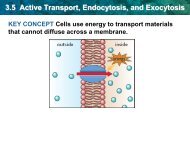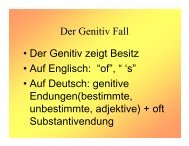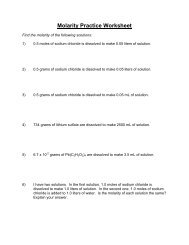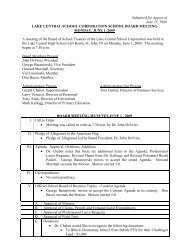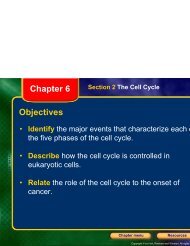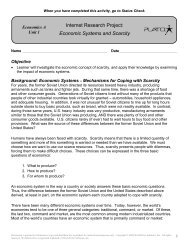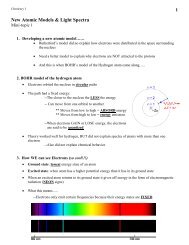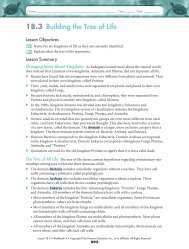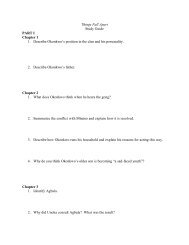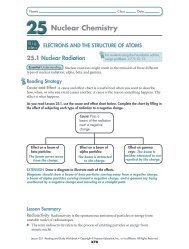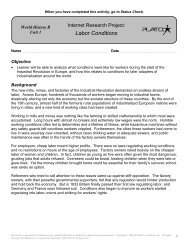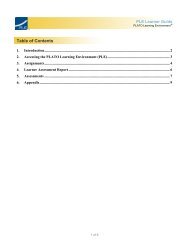Chapter 4.4, 4.5 Notes - Lake Central High School
Chapter 4.4, 4.5 Notes - Lake Central High School
Chapter 4.4, 4.5 Notes - Lake Central High School
Create successful ePaper yourself
Turn your PDF publications into a flip-book with our unique Google optimized e-Paper software.
<strong>Chapter</strong> 5<br />
Section 3 Cellular Respiration<br />
Objectives<br />
• Summarize how glucose is broken down in the first<br />
stage of cellular respiration.<br />
• Describe how ATP is made in the second stage of<br />
cellular respiration.<br />
• Identify the role of fermentation in the second stage<br />
of cellular respiration (next class)<br />
• Evaluate the importance of oxygen in aerobic<br />
respiration.<br />
<strong>Chapter</strong> menu<br />
Resources<br />
Copyright © by Holt, Rinehart and Winston. All rights reserved.
New Vocabulary<br />
• Aerobic<br />
• Anaerobic<br />
• Glycolysis<br />
• Krebs Cycle<br />
• NADH<br />
• FADH 2<br />
• Fermentation<br />
<strong>Chapter</strong> menu<br />
Resources<br />
Copyright © by Holt, Rinehart and Winston. All rights reserved.
• What type of organic compounds are made during<br />
photosynthesis<br />
• Before organisms use the energy in organic<br />
compounds, they must convert this energy to<br />
_________ ATP during the process of _______________<br />
cellular<br />
respiration<br />
__________________<br />
all<br />
Sugars (carbohydrates)<br />
• Remember, ________ organisms respire…even<br />
plants<br />
expire<br />
• If they don’t respire, they ____________<br />
<strong>Chapter</strong> menu<br />
Resources<br />
Copyright © by Holt, Rinehart and Winston. All rights reserved.
<strong>Chapter</strong> 5<br />
Section 3 Cellular Respiration<br />
Oxygen<br />
• __________________ in the air you breathe makes<br />
the production of ATP more efficient, although some<br />
ATP is made ______________ without oxygen.<br />
• Metabolic processes that require oxygen are called<br />
___________________.<br />
aerobic<br />
• Metabolic processes that do not require oxygen are<br />
called _______________, anaerobic which means “without air.<br />
<strong>Chapter</strong> menu<br />
Resources<br />
Copyright © by Holt, Rinehart and Winston. All rights reserved.
<strong>Chapter</strong> 5<br />
Section 3 Cellular Respiration<br />
• In the process of<br />
cellular respiration,<br />
__________________<br />
glucose<br />
is broken down to<br />
produce<br />
____________ energy within<br />
__________________<br />
a mitochondrion<br />
<strong>Chapter</strong> menu<br />
Resources<br />
Copyright © by Holt, Rinehart and Winston. All rights reserved.
Structure of the mitochondrion<br />
2<br />
• _____ membranes<br />
• Inner membrane is<br />
_________ folded<br />
• Space between the two<br />
membranes is called<br />
the ______________<br />
intermembrane<br />
space<br />
• Space inside the inner<br />
membrane is called the<br />
mitochondrial<br />
____________ matrix<br />
matrix<br />
Intermembrane space<br />
<strong>Chapter</strong> menu<br />
Resources<br />
Copyright © by Holt, Rinehart and Winston. All rights reserved.
• The equation for cellular respiration is…<br />
C 6 H 12 O 6 + 6O 2<br />
6CO 2 + 6H 2 O + ATP<br />
Which reactant is needed for cellular respiration to be<br />
efficient<br />
oxygen<br />
In addition to energy, what other products are made<br />
Carbon dioxide, water<br />
<strong>Chapter</strong> menu<br />
Resources<br />
Copyright © by Holt, Rinehart and Winston. All rights reserved.
<strong>Chapter</strong> 5<br />
Section 3 Cellular Respiration<br />
The Stages of Cellular Respiration<br />
• Cellular respiration occurs in three main stages:<br />
Stage 1 Glycolysis: occurs in the ______________<br />
Stage 2 Krebs Cycle: occurs in the _____________<br />
_________ matrix<br />
Stage 3 Electron Transport Chain: occurs along the<br />
folded __________ membrane<br />
inner<br />
cytoplasm<br />
mitochondrial<br />
<strong>Chapter</strong> menu<br />
Resources<br />
Copyright © by Holt, Rinehart and Winston. All rights reserved.
<strong>Chapter</strong> 5<br />
Section 3 Cellular Respiration<br />
Glycolysis<br />
• Process in which ___________ is<br />
broken down into ____________ pyruvates<br />
or _____________ pyruvic acid<br />
• Occurs in the ______________<br />
• Does _____ need oxygen!<br />
• 4 steps<br />
not<br />
glucose<br />
cytoplasm<br />
<strong>Chapter</strong> menu<br />
Resources<br />
Copyright © by Holt, Rinehart and Winston. All rights reserved.
<strong>Chapter</strong> 5<br />
Section 3 Cellular Respiration<br />
Glycolysis: Step 1<br />
2<br />
• _____ ATP jumpstart<br />
glycolysis<br />
2<br />
• ____ phosphates from ATP<br />
join __________ glucose to form an<br />
unstable 6-carbon<br />
compound<br />
<strong>Chapter</strong> menu<br />
Resources<br />
Copyright © by Holt, Rinehart and Winston. All rights reserved.
<strong>Chapter</strong> 5<br />
Section 3 Cellular Respiration<br />
Glycolysis: Step 2<br />
• This unstable 6-carbon<br />
compound immediately<br />
breaks into ____ 2<br />
3-carbon compounds<br />
called ___________ PGAL<br />
<strong>Chapter</strong> menu<br />
Resources<br />
Copyright © by Holt, Rinehart and Winston. All rights reserved.
<strong>Chapter</strong> 5<br />
Section 3 Cellular Respiration<br />
Glycolysis: Step 3<br />
• As glucose is broken<br />
down some of its<br />
___________ hydrogen atoms join<br />
_________ NAD + to form<br />
__________, NADH which is an<br />
energy storing molecule<br />
• The hydrogen atoms are<br />
replaced by two more<br />
__________ phosphate groups<br />
<strong>Chapter</strong> menu<br />
Resources<br />
Copyright © by Holt, Rinehart and Winston. All rights reserved.
<strong>Chapter</strong> 5<br />
Section 3 Cellular Respiration<br />
Glycolysis: Step 4<br />
• The ____ 4 phosphates bond<br />
with 4 molecules of ADP to<br />
make 4 _______ ATP molecules<br />
• The remaining products are<br />
two 3-carbon pyruvates,<br />
which are ions of<br />
___________ pyruvic ________ acid<br />
• Remember that 2 ATP are needed to start the process,<br />
so glycolysis produces a net gain of ______ 2 ATP<br />
<strong>Chapter</strong> menu<br />
Resources<br />
Copyright © by Holt, Rinehart and Winston. All rights reserved.
<strong>Chapter</strong> 5<br />
Section 3 Cellular Respiration<br />
Entering the Mitochondria<br />
• The 3-carbon pyruvates are small enough to<br />
___________ diffuse through the mitochondrial membranes,<br />
where they are each broken down into….<br />
– One ________ CO 2<br />
– One 2-carbon compound called an ___________ acetyl<br />
____________ group<br />
<strong>Chapter</strong> menu<br />
Resources<br />
Copyright © by Holt, Rinehart and Winston. All rights reserved.
<strong>Chapter</strong> 5<br />
Section 3 Cellular Respiration<br />
• This process releases another hydrogen atom which<br />
joins NAD + to make one more molecule of<br />
__________ NADH<br />
• The acetyl group is attached to a molecule called<br />
______________, Coenzyme A (______) CoA forming the compound<br />
_________________<br />
Acetyl-CoA<br />
<strong>Chapter</strong> menu<br />
Resources<br />
Copyright © by Holt, Rinehart and Winston. All rights reserved.
• Each acetyl CoA enters the _________ Krebs cycle to start<br />
stage 2 of cellular respiration<br />
– It turns __________, twice once for each acetyl CoA<br />
– This cycle is name after ___________________,<br />
Hans Krebs<br />
the scientist who discovered it<br />
– Occurs in ____ 4 main steps<br />
<strong>Chapter</strong> menu<br />
Resources<br />
Copyright © by Holt, Rinehart and Winston. All rights reserved.
<strong>Chapter</strong> 5<br />
Section 3 Cellular Respiration<br />
Stage Two: Krebs Cycle (Step 1)<br />
• Acetyl-CoA<br />
enters the Krebs<br />
cycle by joining<br />
a 4-carbon<br />
compound<br />
called<br />
_____________<br />
oxaloacetic<br />
_____________<br />
acid<br />
<strong>Chapter</strong> menu<br />
Resources<br />
Copyright © by Holt, Rinehart and Winston. All rights reserved.
<strong>Chapter</strong> 5<br />
Section 3 Cellular Respiration<br />
Stage Two: Krebs Cycle (Step 1)<br />
• The new 6-carbon<br />
compound is called<br />
_____________ citric<br />
___________ acid<br />
• Since this is the<br />
first product of the<br />
Krebs cycle, it also<br />
often called the<br />
_____________ citric<br />
_________ acid cycle<br />
<strong>Chapter</strong> menu<br />
Resources<br />
Copyright © by Holt, Rinehart and Winston. All rights reserved.
<strong>Chapter</strong> 5<br />
Section 3 Cellular Respiration<br />
Stage Two: Krebs Cycle (Step 2)<br />
CO 2<br />
5<br />
• _____ is released<br />
from citric acid,<br />
resulting in a ___<br />
carbon compound<br />
<strong>Chapter</strong> menu<br />
Resources<br />
Copyright © by Holt, Rinehart and Winston. All rights reserved.
<strong>Chapter</strong> 5<br />
Section 3 Cellular Respiration<br />
Stage Two: Krebs Cycle (Step 3)<br />
CO 2<br />
4<br />
• _____ is released<br />
from the 5-carbon<br />
compound, forming<br />
a ____ carbon<br />
compound<br />
• So how many<br />
molecules of CO 2<br />
are made during<br />
the Krebs cycle<br />
2, but it turns<br />
twice so 4<br />
<strong>Chapter</strong> menu<br />
Resources<br />
Copyright © by Holt, Rinehart and Winston. All rights reserved.
<strong>Chapter</strong> 5<br />
Section 3 Cellular Respiration<br />
Stage Two: Krebs Cycle (Step 4)<br />
• The 4-carbon<br />
compound is<br />
_____________,<br />
rearranged<br />
making<br />
oxaloacetic acid<br />
available for the<br />
cycle again<br />
<strong>Chapter</strong> menu<br />
Resources<br />
Copyright © by Holt, Rinehart and Winston. All rights reserved.
<strong>Chapter</strong> 5<br />
Section 3 Cellular Respiration<br />
• This cycle also<br />
makes energy<br />
storing<br />
compounds…<br />
– ____ 3 NADH<br />
– ____ 1 ATP<br />
– ____ 1 FADH 2<br />
• Remember that the<br />
cycle turns twice,<br />
so it is really…<br />
– ____ 6 NADH<br />
– ____ ATP<br />
– ____ 2 FADH 2<br />
2<br />
<strong>Chapter</strong> menu<br />
Resources<br />
Copyright © by Holt, Rinehart and Winston. All rights reserved.
<strong>Chapter</strong> 5<br />
Section 3 Cellular Respiration<br />
Stage Three: Electron Transport Chain<br />
• _________ NADH and ________ FADH 2 carry high energy<br />
_________ electrons to the inner membrane of the<br />
mitochondria, where they pass through an<br />
______________ electron _____________ transport chain<br />
<strong>Chapter</strong> menu<br />
Resources<br />
Copyright © by Holt, Rinehart and Winston. All rights reserved.
<strong>Chapter</strong> 5<br />
Section 3 Cellular Respiration<br />
• The energy released from the moving electrons is<br />
used to pump _____________ hydrogen ions from<br />
mitochondrial matrix to the _______________ intermembrane space<br />
<strong>Chapter</strong> menu<br />
Resources<br />
Copyright © by Holt, Rinehart and Winston. All rights reserved.
<strong>Chapter</strong> 5<br />
Section 3 Cellular Respiration<br />
• This creates a build-up of hydrogen ions which will<br />
_____________ diffuse through the ATP _____________<br />
synthetase<br />
pump, producing __________ large amounts of ATP<br />
<strong>Chapter</strong> menu<br />
Resources<br />
Copyright © by Holt, Rinehart and Winston. All rights reserved.
<strong>Chapter</strong> 5<br />
Section 3 Cellular Respiration<br />
• As the diffusion of water is called osmosis, the<br />
diffusion of chemicals, like H + , is called<br />
___________________<br />
chemiosmosis<br />
<strong>Chapter</strong> menu<br />
Resources<br />
Copyright © by Holt, Rinehart and Winston. All rights reserved.
<strong>Chapter</strong> 5<br />
Section 3 Cellular Respiration<br />
• The last molecule in the electron transport chain to<br />
receive an electron is oxygen gas _______. O 2 It binds<br />
with hydrogen ions to make _________ H 2 O<br />
<strong>Chapter</strong> menu<br />
Resources<br />
Copyright © by Holt, Rinehart and Winston. All rights reserved.
<strong>Chapter</strong> 5<br />
Section 3 Cellular Respiration<br />
• Without ___________, oxygen the electron transport chain<br />
cannot pass along electrons and it easily gets<br />
_________ blocked or clogged up<br />
<strong>Chapter</strong> menu<br />
Resources<br />
Copyright © by Holt, Rinehart and Winston. All rights reserved.
<strong>Chapter</strong> 5<br />
Section 3 Cellular Respiration<br />
• This is why oxygen is so essential for most<br />
organisms…without it the electron transport chain will<br />
_____ stop working and _____ ATP will no longer be produced<br />
<strong>Chapter</strong> menu<br />
Resources<br />
Copyright © by Holt, Rinehart and Winston. All rights reserved.
• The process of making large amounts of ATP in the<br />
electron transport chain is called ______________<br />
oxidative<br />
______________________<br />
phosphorylation<br />
– Oxidation results when ___________ electrons are lost or<br />
donated to other molecules<br />
• Electrons are _________ passed from molecule to<br />
molecule in the electron transport chain<br />
– Phosphorylation occurs when a ____________ phosphate<br />
group is added to a molecule<br />
• Phosphates are added to _____ ADP<br />
<strong>Chapter</strong> menu<br />
Resources<br />
Copyright © by Holt, Rinehart and Winston. All rights reserved.
• Summary of ATP made during cellular respiration<br />
– Glycolysis = ____ 2 ATP<br />
– Krebs Cycle = ____ 2 ATP<br />
– Electron Transport Chain = ____ 32 ATP to ___ 34 ATP<br />
– Total… = ____ 36 ATP to ___ 38 ATP<br />
<strong>Chapter</strong> menu<br />
Resources<br />
Copyright © by Holt, Rinehart and Winston. All rights reserved.
Question 1<br />
• What substance is broken down during cellular<br />
respiration<br />
A. CO 2 (carbon dioxide)<br />
B. H 2 O (water)<br />
C. O 2 (oxygen)<br />
D. C 6 H 12 O 6 (glucose)<br />
<strong>Chapter</strong> menu<br />
Resources<br />
Copyright © by Holt, Rinehart and Winston. All rights reserved.
Question 2<br />
• Why must glucose be converted to 2 pyruvates in<br />
the cytoplasm, before these molecules cross<br />
through the mitochondrial membranes<br />
Glucose is too big to diffuse across<br />
the membranes<br />
<strong>Chapter</strong> menu<br />
Resources<br />
Copyright © by Holt, Rinehart and Winston. All rights reserved.
Question 3<br />
• What is the first compound made during the Krebs<br />
cycle<br />
A. Oxaloacetic acid<br />
B. Citric acid<br />
C. Acetyl CoA<br />
D. pyruvate<br />
<strong>Chapter</strong> menu<br />
Resources<br />
Copyright © by Holt, Rinehart and Winston. All rights reserved.
Question 4<br />
• Which energy storing compound is not made during<br />
the Krebs cycle<br />
A. ATP<br />
B. NADH<br />
C. NADPH<br />
D. FADH 2<br />
<strong>Chapter</strong> menu<br />
Resources<br />
Copyright © by Holt, Rinehart and Winston. All rights reserved.
Question 5<br />
• Which molecule is necessary to prevent the electron<br />
transport chain from becoming clogged or backed<br />
up<br />
A. CO 2 (carbon dioxide)<br />
B. H 2 O (water)<br />
C. O 2 (oxygen)<br />
D. C 6 H 12 O 6 (glucose)<br />
<strong>Chapter</strong> menu<br />
Resources<br />
Copyright © by Holt, Rinehart and Winston. All rights reserved.



